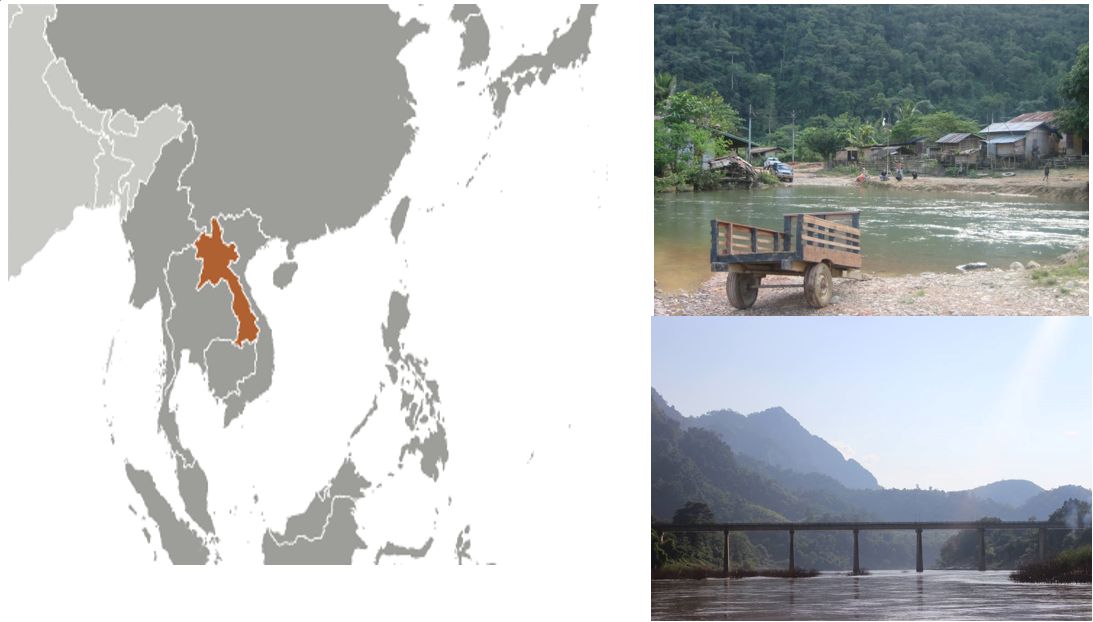The Lao PDR has an area of 236,800 sq.km and about 90% of that area is located within the Mekong river basin (see Figure below). Lao PDR is rich in water resources and has a per capita water resources of 55,000 m3 per year. About 35% (about 270,000 m3) of the Mekong river annual flow is contributed from its tributaries within Laos.

Lao PDR has developed a National Water Resources Strategy 2020. The vision of the Strategy is as follows:
Coordinated, optimized and sustainable development and use of water resources, protection of the environment and improvement of social well-being
The Mission Statements of the Strategy are listed below:
- ensure sustainable development and management of water resources and minimize water environment and social impacts,
- management and protection of water sources and systematic, comprehensive planning for water resources development and use, balancing socioeconomic outcomes and water ecosystems,
- strengthening ownership and participation of stakeholders on management of water resources development and use through capacity building and use of local knowledge,
- prioritization of water allocation for basic human needs, ensure equitable water uses and sharing the benefits of water availability and development.
The 11 Components of the Lao PDR Water Resources Strategic Plan 2020 are as follows:
- Institutional Strengthening & Coordination
- Legislation, Plans and Implementation
- RB and Sub-RBs WR Planning
- Groundwater Management
- Data & Information Management
- Water Allocation
- Protection of Water Quality and Ecosystems
- Wetland Management
- Flood and Drought Management
- WR Risk Management & Climate Change Adaptation
- IWRM Financing
- Awareness, Participation & Capacity Building
The following is an overview of the IWRM status in Laos for the key water management issues in Lao PDR.
- Water Supply and Sanitation Management
The National Center of Environmental Health and Water Supply (commonly known as Nam Saat) under the Ministry of Public Health is responsible for the management of the technical aspects of rural water supply, and also urban and rural environmental hygiene throughout the country. Urban water supply systems are owned by the provincial governments and are managed through a delegated model of state-owned enterprises. Nam Saat focuses on increasing public awareness, community ownership and public participation in the development and implementation process of rural water supply, and urban and rural sanitation.
- Irrigation Management
The irrigation sector has been given a high priority to ensure stabilization and sustainability of the main agricultural crops, particularly rice which is the country’s main agricultural product. The Government has made large investments in the construction of the irrigation infrastructure, particularly irrigation systems to enhance agricultural production. The irrigation service area is about 300,000 ha. during the wet season.
- Flood and Stormwater Management
Most of the cities and towns of Lao PDR lie along the Mekong River and its tributaries and are thus prone to flooding due to over bank flows during the rainy season. The following are some of the strategies that have been identified to address the flooding issue and to manage stormwater.
- Better land use planning and land use regulations
- Designated and protected floodways and flood retention areas
- Flood protection levees and better sitting of the levees
- Pumping stations and storm-water drains to relieve flooding when it occurs
- Flood warning and emergency management systems
Â
- Water Pollution Management
To manage water pollution the Lao PDR has formulated and implemented a capacity building plan for monitoring, rehabilitation and management of water quality and aquatic ecosystem health at both central and local levels, with the participation of the community. A Pilot project on water quality monitoring in river basins and sub-basin and the development of guidelines has been implemented. The project includes the identification of water quality monitoring point surveys and wastewater management, on-the-job training on water quality management, etc. To date, at least 144 water quality monitoring points have been identified in eight provinces and work to identify additional points are continuing in the other remaining provinces.
